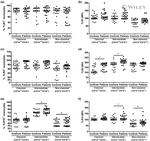Search Thermo Fisher Scientific
Invitrogen
CD281 (TLR1) Monoclonal Antibody (GD2.F4), PE, eBioscience™
Product Details
12-9911-42
Species Reactivity
Published species
Host/Isotype
Recommended Isotype Control
Class
Type
Clone
Conjugate
Excitation/Emission Max
Form
Concentration
Purification
Storage buffer
Contains
Storage conditions
Shipping conditions
RRID
Product Specific Information
Description: The GD2.F4 antibody reacts with human Toll-like receptor 1 (TLR1). TLR1 is expressed in low numbers on the surface of peripheral blood monocytes and even lower numbers on dendritic cells. A very high degree of donor variability has been reported for TLR1 expression. eBioscience manufactured GD2.F4 mAb has been tested by flow cytometry, in parallel with a sample from the developer using cells from healthy donors. eBioscience and the reference antibody gave similar results: donors tested confirmed low levels expression of TLR1 on PBMC (less than 1/4 log shift). While the ligand and exact function of TLR1 are not defined yet, it has been suggested that TLR1 may cooperate with TLR2 in response to certain antagonists. Despite low levels of surface expression as detected by flow cytometric analysis, TLRs are efficient signal transducing molecules in monocytes and dendritic cells. To date, at least ten members of the Toll family have been identified in human. This family of type I transmembrane proteins is characterized by an extracellular domain with leucine-rich repeats and a cytoplasmic domain with homology to the type I IL-1 receptor. Two of these receptors, TLR2 and TLR4, are pattern recognition receptors and signaling molecules in response to bacterial lipoproteins and have been implicated in innate immunity and inflammation.
Applications Reported: The GD2.F4 antibody has been reported for use in flow cytometric analysis.
Applications Tested: The GD2.F4 antibody has been pre-titrated and tested by flow cytometric analysis of normal human peripheral blood cells. This can be used at 5 µL (1 µg) per test. A test is defined as the amount (µg) of antibody that will stain a cell sample in a final volume of 100 µL. Cell number should be determined empirically but can range from 10^5 to 10^8 cells/test.
Excitation: 488-561 nm; Emission: 578 nm; Laser: Blue Laser, Green Laser, Yellow-Green Laser.
Filtration: 0.2 µm post-manufacturing filtered.
Target Information
TLR1 protein is a member of the Toll-like receptor (TLR) family which plays a fundamental role in pathogen recognition and activation of innate immunity. TLRs are highly conserved from Drosophila to humans and share structural and functional similarities. They recognize pathogen-associated molecular patterns (PAMPs) that are expressed on infectious agents, and mediate the production of cytokines necessary for the development of effective immunity. The various TLRs exhibit different patterns of expression. The Toll-like receptor (TLR) family in mammals are comprised of a family of transmembrane proteins characterized by multiple copies of leucine rich repeats in the extracellular domain and an IL-1 receptor motif in the cytoplasmic domain. The TLRs could constitute an important and unrecognized component of innate immunity in humans. In mice, TLR1 interacts with TLR2 and co-expression of TLR1 and TLR2 enhance the NF-kappaB activation in response to a synthetic lipopeptide. They recognize the lipid configuration of the native mycobacterial lipoprotein as well as several tri-acylated lipopeptides. Different length transcripts presumably resulting from use of alternative polyadenylation site, and/or from alternative splicing, have been noted for the TLR1 gene.
For Research Use Only. Not for use in diagnostic procedures. Not for resale without express authorization.
How to use the Panel Builder
Watch the video to learn how to use the Invitrogen Flow Cytometry Panel Builder to build your next flow cytometry panel in 5 easy steps.
Bioinformatics
Protein Aliases: CD281; TIL; Toll-like receptor 1; Toll/interleukin-1 receptor-like protein
Gene Aliases: CD281; KIAA0012; rsc786; TIL; TIL. LPRS5; TLR1
UniProt ID: (Human) Q15399
Entrez Gene ID: (Human) 7096

Performance Guarantee
If an Invitrogen™ antibody doesn't perform as described on our website or datasheet,we'll replace the product at no cost to you, or provide you with a credit for a future purchase.*
Learn more
We're here to help
Get expert recommendations for common problems or connect directly with an on staff expert for technical assistance related to applications, equipment and general product use.
Contact tech support
-Flow-20170216130641.jpg?time=20220826)
-Flow-20170216130641.jpg?time=20220826)

